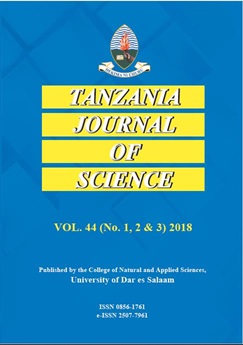Lipophilic Wood Extractives ' Contamination of Water Bodies in the Vicinity of Pulp and Paper Mill, Southern Tanzania
Abstract
This paper reports on the levels of fatty acids and selected sterols in effluents and nearby water bodies at Mufindi Paper Mill (MPM), southern Tanzania. Solid Phase Extraction (SPE) was used for sample extraction, and analysis was performed using Gas Chromatography-Mass Spectrometer (GC-MS). Fatty acids ranging from C11:0 to C25:0 were detected, with saturated fatty acids (SFA) being more abundant than unsaturated fatty acids (USFA). As for selected sterols, β-sitosterol and stigmastanol were more abundant than campesterol. The mean levels of SFA, USFA, β-sitosterol, stigmastanol, and campesterol ( µg/L) were 538.28, 125.94, 1065.44, 1178.01, and 66.76, respectively, for untreated effluents, and 338.10, 139.03, 933.40, 153.92 and 57.82, respectively, for treated effluents. It was further established that the mean levels of SFA, USFA, β-sitosterol, stigmastanol, and campesterol ( µg/L) were 321.29, 57.35, 58.37, 50.76, and 49.08, respectively, for effluents at the discharge point and 20.58, 17.72, 8.25, 10.55, and 6.05, respectively, at receiving water. Water bodies are therefore contaminated with lipophilic wood extractives since the mean concentration levels of USFA and sterols were above the lowest concentrations suspected to adversely affect fish (toxic limits ( µg/L): USFA (2-8) and sterols ( ³10)).
Keywords: Pulp and paper; wood extractives; fatty acids; sterols; contamination;


